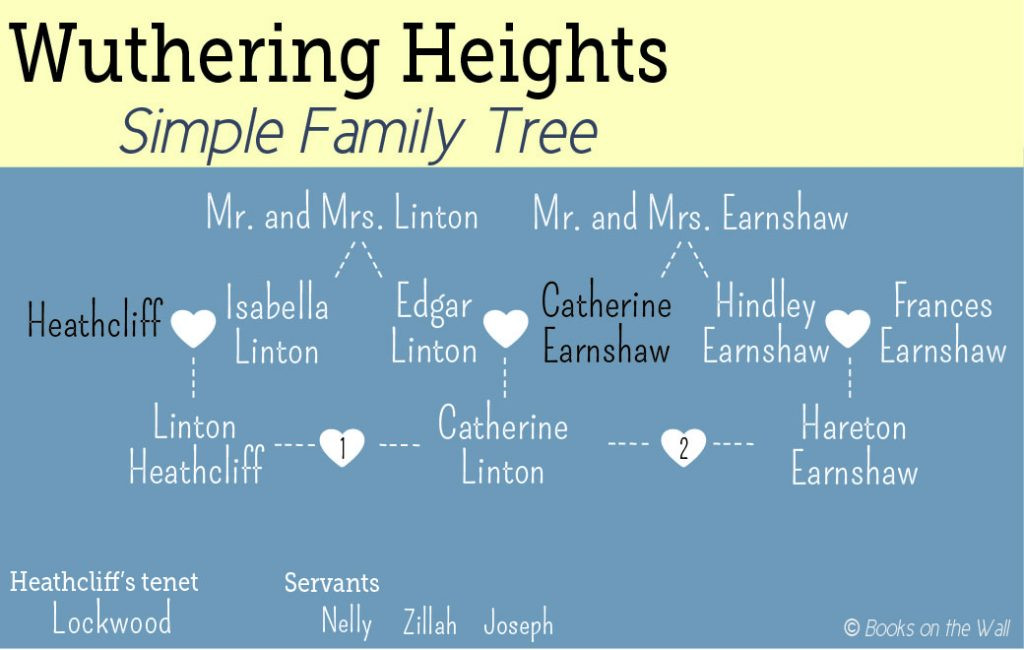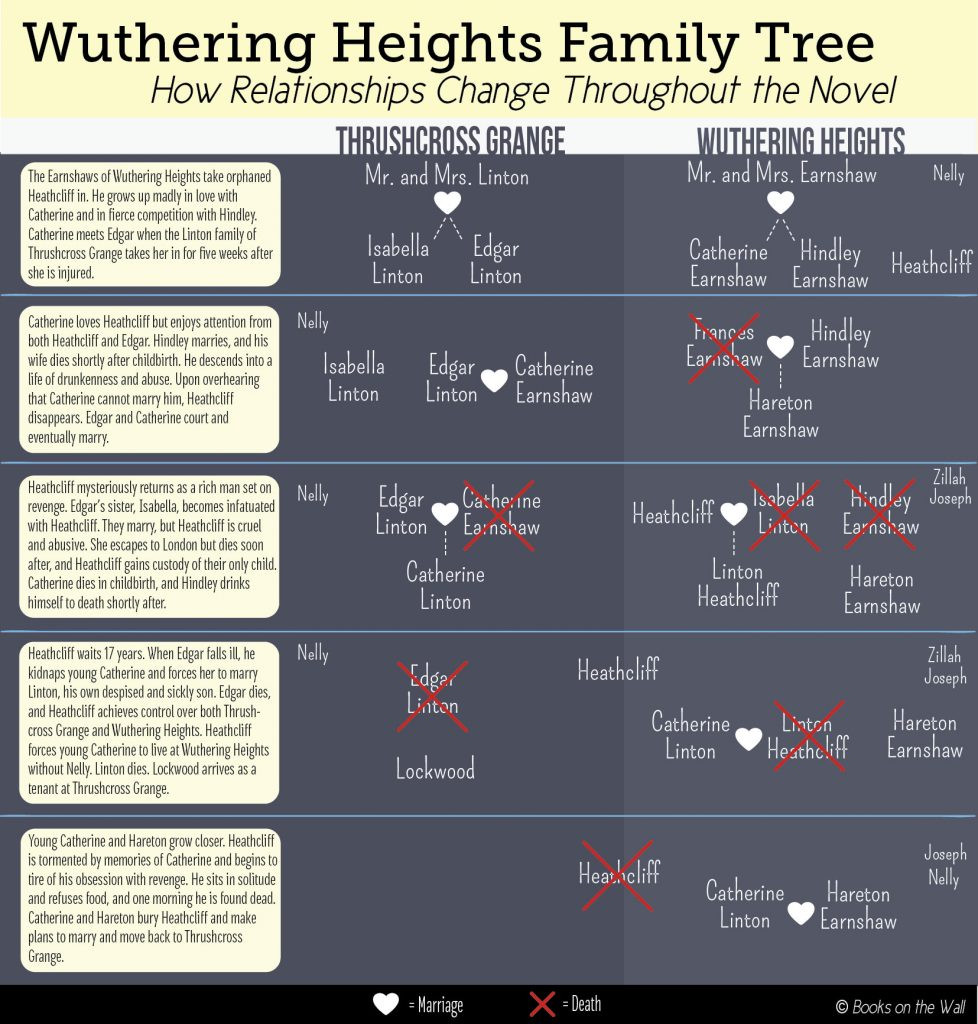Embarking on Emily Brontë’s Wuthering Heights can feel like stepping into a labyrinth of tangled relationships, passionate betrayals, and a family history spanning generations. At the heart of this gothic masterpiece lies the intricate web connecting the Earnshaw and Linton families, all dramatically impacted by the enigmatic and vengeful Heathcliff. To truly grasp the depth and drama of Wuthering Heights, understanding the family tree is paramount.
This article serves as your definitive guide to the Wuthering Heights family tree, meticulously detailing each character and their connections. We’ll move beyond a simple list, delving into the evolving dynamics and pivotal events that shape these relationships throughout the novel. Whether you’re a student approaching Wuthering Heights for the first time or a seasoned reader seeking a clearer understanding, this comprehensive exploration of the family tree will illuminate the novel’s complex world. Let’s unravel the lineages of Wuthering Heights and Thrushcross Grange and clarify how each character contributes to this timeless tale of love, revenge, and societal constraints.
Visualizing the Wuthering Heights Character Map: From Simple to Complex
The relationships in Wuthering Heights are not static; they twist and turn with each act of love, betrayal, and death. To begin, let’s look at a straightforward Wuthering Heights family tree that outlines the basic connections between the key players: the Earnshaws, the Lintons, and Heathcliff.
 Simple Wuthering Heights family tree showing basic relationships between Earnshaws, Lintons and Heathcliff
Simple Wuthering Heights family tree showing basic relationships between Earnshaws, Lintons and Heathcliff
This initial Wuthering Heights family tree provides a foundational understanding of the core relationships. However, as you delve deeper into Brontë’s narrative, you’ll discover that the dynamics shift dramatically over time. Heathcliff, initially an outsider, becomes deeply intertwined with both families, driven by his consuming love for Catherine Earnshaw and his subsequent thirst for revenge when denied her hand in marriage. His machinations ripple through generations, altering the power balance and the fates of those connected to Wuthering Heights and Thrushcross Grange.
To fully appreciate the novel’s narrative arc, it’s essential to consider how these relationships evolve. The following expanded Wuthering Heights family tree not only illustrates the initial connections but also incorporates the significant events that reshape these bonds: marriages, deaths, and the shifting control of the estates.
 Detailed Wuthering Heights character map illustrating evolving relationships, marriages, deaths, and estate control over time
Detailed Wuthering Heights character map illustrating evolving relationships, marriages, deaths, and estate control over time
This more detailed Wuthering Heights character map reveals the progression of the story, highlighting how relationships are forged, broken, and transformed by the relentless passage of time and the tumultuous events within the narrative. Understanding this dynamic family tree is crucial for grasping the full scope of Wuthering Heights.
Exploring the Core Themes of Wuthering Heights: Beyond the Family Tree
While the Wuthering Heights family tree is indispensable for navigating the characters, the novel’s power extends far beyond lineage. Brontë masterfully weaves themes of class, passion versus reason, nature versus culture, and the destructive force of revenge into the fabric of her story.
Wuthering Heights is often compared to Jane Austen’s Sense and Sensibility, but where Austen gently explores the nuances of societal expectations and romantic entanglements, Brontë plunges into the darker depths of human emotion. Wuthering Heights presents a starker, more untamed vision, set against the wild Yorkshire moors, reflecting the raw and unrestrained passions of its characters.
The novel’s initial reception was mixed, with some critics and readers struggling to reconcile with its stark realism and intense emotional landscape. Writing under the pseudonym Ellis Bell, Emily Brontë defied the conventions of her time, crafting a narrative that explored obsession, love, and revenge with unflinching honesty. Sadly, Brontë passed away shortly after Wuthering Heights was published, unaware of the enduring legacy her work would achieve.
Today, Wuthering Heights is firmly established as a cornerstone of English literature. Its themes resonate across generations, and the passionate, tormented figures of Catherine and Heathcliff remain iconic. However, the sheer number of characters and their intertwined relationships can be daunting for new readers. This is where the Wuthering Heights family tree becomes an invaluable tool, helping to keep track of who’s who and how they are connected.
Key Characters in Wuthering Heights: A Detailed Breakdown
To further clarify the Wuthering Heights family tree, let’s examine each significant character, outlining their role and relationships within the narrative:
Heathcliff
Heathcliff stands as one of literature’s most compelling and controversial figures. Introduced as an orphan of mysterious origins found on the streets of Liverpool by Mr. Earnshaw, Heathcliff’s brooding nature, passionate intensity, and vengeful spirit define his character. From the moment he arrives at Wuthering Heights in 1771, he disrupts the family’s dynamic, becoming the object of both affection and animosity.
While Hindley Earnshaw immediately resents Heathcliff, Catherine Earnshaw forms a deep, almost mystical bond with him. However, societal pressures and Catherine’s own ambitions lead her to choose the refined Edgar Linton over Heathcliff. This rejection fuels Heathcliff’s descent into bitterness and revenge, which permeates the entire second half of the novel.
Heathcliff’s love for Catherine is all-consuming, bordering on obsession. His famous quote, “I cannot live without my life! I cannot live without my soul!” encapsulates the depth of his passion and despair. Literary scholars often draw parallels between Heathcliff and the Byronic hero – melancholic, passionate, and rebellious figures popularized by Lord Byron. Yet, Heathcliff transcends simple imitation, becoming a unique creation of Emily Brontë’s imagination, a symbol of untamed passion and the destructive consequences of societal barriers.
The Earnshaw Lineage
Catherine Earnshaw
Born in 1765, Catherine is the spirited daughter of Mr. and Mrs. Earnshaw and Hindley’s younger sister. Her bond with Heathcliff is the emotional nucleus of Wuthering Heights. In her youth, Catherine is wild and untamed, mirroring the rugged landscape of the moors. Her defining physical traits – brown eyes and hair – are echoed in later generations, symbolizing a continuing lineage of passionate spirits.
A pivotal turning point occurs when Catherine is injured at Thrushcross Grange and spends time recovering with the Lintons. This exposure to their refined world instigates a transformation in Catherine, drawing her towards societal acceptance and the allure of wealth and status. Despite her profound connection with Heathcliff, she marries Edgar Linton in 1783, a decision driven by both social ambition and a fear of her own untamed nature.
Catherine’s famous declaration, “I am Heathcliff,” reveals the depth of their intertwined identities. She recognizes their souls as intrinsically linked, yet chooses a path that ultimately separates them physically and socially. Her internal conflict embodies the central tension of the novel: the pull between passionate, natural love and the constraints of civilized society. Catherine’s untimely death in 1784, shortly after giving birth to her daughter Cathy Linton, sets in motion the tragic events of the subsequent generation, her ghost lingering as a symbol of unresolved passions and the enduring power of the past.
Hindley Earnshaw
Born in 1757, Hindley Earnshaw embodies the destructive nature of jealousy and resentment. From Heathcliff’s arrival, Hindley harbors intense animosity, fueled by his father’s apparent preference for the adopted orphan. This jealousy festers and shapes Hindley’s life, driving him to cruelty and self-destruction.
Hindley marries Frances and fathers Hareton Earnshaw, but his life is marred by tragedy and fueled by his obsession with undermining Heathcliff. After his father’s death, Hindley returns to Wuthering Heights as master, treating Heathcliff with increasing brutality. Consumed by alcoholism, gambling, and a thirst for revenge, Hindley represents another cautionary tale within Wuthering Heights, illustrating how unchecked obsession can corrupt and destroy an individual.
Mr. Earnshaw
The patriarch of the Earnshaw family and owner of Wuthering Heights, Mr. Earnshaw is a complex figure. Described as somewhat rough, he displays a generous heart in bringing Heathcliff into his home. However, his apparent favoritism towards Heathcliff ignites the central conflict of the novel, setting brother against adopted brother and creating lasting resentment.
Mr. Earnshaw’s motivations for favoring Heathcliff remain somewhat ambiguous, contributing to the novel’s layers of psychological complexity. His death in 1777 marks a significant shift in the power dynamics at Wuthering Heights, leaving Hindley in control and Heathcliff vulnerable to abuse.
Mrs. Earnshaw
Mrs. Earnshaw plays a minor but telling role. Her disapproval of Heathcliff’s arrival, rooted in concerns about household resources, highlights the societal prejudices of the time. Her early death in 1773 further destabilizes the Earnshaw household and removes a potential source of maternal influence for both Hindley and Catherine.
The Linton Lineage
Edgar Linton
Edgar Linton represents civilization, refinement, and societal order in Wuthering Heights, contrasting sharply with Heathcliff’s untamed nature. Born in 1762 into the wealthy Linton family at Thrushcross Grange, Edgar embodies the values of the landed gentry – politeness, education, and social decorum.
While undeniably cultured and well-mannered, Edgar is also portrayed as somewhat weak and sheltered compared to Heathcliff’s raw vitality. His social standing and refined demeanor attract Catherine, offering her a path to respectability and comfort. However, his inherent snobbery and inability to comprehend the depth of passion that exists between Catherine and Heathcliff fuel the ongoing conflict.
Despite his limitations, Edgar genuinely loves Catherine in his own way and proves to be a devoted father to their daughter, Cathy. His unwavering commitment to Thrushcross Grange and its values represents a contrasting worldview to that of Wuthering Heights, highlighting the societal divisions and conflicting desires within the novel. Edgar Linton dies in 1801, leaving his daughter to navigate the complexities of her inheritance and the lingering shadow of Heathcliff.
Isabella Linton
Isabella Linton serves as a foil to Catherine, embodying a more superficial understanding of romance and passion. Born in 1765, Isabella shares Edgar’s refined upbringing but lacks Catherine’s depth and complexity. Her infatuation with Heathcliff is naive and ill-fated, driven by a romanticized image of him rather than a true understanding of his character.
Isabella’s marriage to Heathcliff in 1784 is a disaster, a tool of revenge for Heathcliff and a source of misery for Isabella. She endures abuse and neglect, eventually fleeing to London to escape his cruelty. Her son, Linton Heathcliff, is born out of this unhappy union, inheriting the worst traits of both parents. Isabella’s tragic fate underscores the dangers of romantic delusion and the destructive consequences of Heathcliff’s vengeful nature. She dies in 1797, leaving her frail son vulnerable to Heathcliff’s manipulations.
The Third Generation: Bridging the Divide
Cathy Linton
Cathy Linton, born in 1784, embodies a blend of her parents’ characteristics, inheriting Catherine’s beauty and spirited nature and Edgar’s refined upbringing. Her flaxen hair distinguishes her from her mother’s darker features, perhaps symbolizing a shift towards a less turbulent future. Cathy’s initial upbringing at Thrushcross Grange shields her from the darker aspects of the Earnshaw-Linton feud, but Heathcliff’s relentless pursuit of revenge draws her into the tangled web of the past.
Cathy’s marriages – first to her sickly cousin Linton Heathcliff and later to her cousin Hareton Earnshaw – are pivotal in resolving the conflicts of previous generations. Initially, Cathy displays a degree of Linton-like snobbery towards Hareton, reflecting the class divisions that have fueled much of the novel’s drama. However, through mutual learning and growing affection, Cathy and Hareton bridge the gap between Wuthering Heights and Thrushcross Grange, suggesting a possibility of reconciliation and a brighter future.
Linton Heathcliff
Linton Heathcliff, born in 1784, is the unfortunate product of his parents’ disastrous marriage. Inheriting Heathcliff’s negative traits – anger, vindictiveness, and selfishness – without any of his father’s passionate intensity or capacity for love, Linton is a sickly and manipulative character. Raised by his mother in London, he is largely unknown to Heathcliff until after Isabella’s death.
Heathcliff summons Linton to Wuthering Heights purely to use him as a pawn in his revenge scheme against Edgar Linton. Linton’s forced marriage to Cathy is a cruel manipulation designed to secure Heathcliff’s control over Thrushcross Grange. Linton’s frail constitution and unpleasant personality make him a largely unsympathetic character, and his early death from tuberculosis in 1801 is almost a relief, ending his role as a tool of his father’s vengeance.
Hareton Earnshaw
Hareton Earnshaw, born in 1778, represents a potential for redemption within the Earnshaw line. Hindley’s son, Hareton, is subjected to Heathcliff’s manipulative upbringing after Hindley’s death, designed to degrade and exploit him, mirroring Heathcliff’s own mistreatment as a child. Despite being denied education and raised in rough conditions, Hareton possesses an inherent goodness and a capacity for growth.
Hareton’s physical description – brown hair and eyes like Catherine and Cathy – links him to the passionate Earnshaw lineage, but his character arc diverges from the destructive patterns of the past. His burgeoning relationship with Cathy Linton, fueled by mutual learning and respect, offers a glimmer of hope for breaking the cycle of violence and revenge. Their eventual marriage in 1803 symbolizes a potential union of the Earnshaw and Linton estates, based not on manipulation and bitterness but on genuine affection and the promise of a more harmonious future.
Narrators and Outsiders: Perspectives on the Family Saga
Mr. Lockwood
Mr. Lockwood serves as the frame narrator of Wuthering Heights, an outsider whose experiences initiate the recounting of the Earnshaw-Linton history. Seeking solitude and escape from society, Lockwood’s arrival at Thrushcross Grange in 1801 sets the stage for Nelly Dean’s narrative. His somewhat aloof and snobbish personality initially positions him as a representative of the outside world, encountering the raw passions of the moors with a degree of incomprehension.
Lockwood’s famous encounter with Catherine’s ghost at the beginning of the novel immediately establishes the supernatural and unsettling atmosphere of Wuthering Heights. His attempts to understand the family history through Heathcliff and Nelly Dean reveal his limitations as a narrator, highlighting the subjective nature of storytelling and the challenges of truly understanding the intense emotions driving the central characters. Ultimately, Lockwood’s retreat back to the city suggests a preference for civilized order over the untamed passions he witnesses, reinforcing one of the novel’s central thematic tensions.
Nelly Dean
Nelly Dean is the primary narrator of Wuthering Heights, recounting the intricate family history to Mr. Lockwood. Born in 1757 and serving as a maid at Thrushcross Grange and Wuthering Heights for generations, Nelly is deeply embedded in the lives of both families. Her perspective shapes our understanding of events, offering intimate details and personal insights into the characters’ motivations.
However, it is crucial to recognize Nelly Dean as a biased narrator. Her own values and judgments inevitably color her storytelling. She admits to disliking Heathcliff from childhood and often presents events from a moralistic standpoint, favoring the Lintons’ civilized values over the Earnshaws’ more untamed nature. Despite her biases, Nelly’s narrative is essential to unraveling the complex plot of Wuthering Heights, providing a human perspective on the epic saga of love and revenge. Her long-term presence within both households makes her a unique witness to the unfolding drama, even as her interpretations must be viewed critically.
Beyond the Screen: Experiencing Wuthering Heights in its Full Form
While film adaptations of Wuthering Heights offer visual interpretations of Brontë’s masterpiece, they can only capture a fraction of the novel’s depth and complexity. To truly appreciate the power of Wuthering Heights, engaging with Brontë’s prose directly is essential. The novel’s language, atmosphere, and intricate narrative structure are best experienced through reading the original text.
Conclusion: Unveiling the Tapestry of Wuthering Heights
By tracing the Wuthering Heights family tree and examining the key characters, we gain a clearer understanding of the novel’s intricate structure and enduring themes. The Earnshaws, the Lintons, and Heathcliff are not merely names on a chart; they are complex individuals driven by passion, ambition, and the legacies of the past. Understanding their relationships, both simple and complex, opens up a richer appreciation for Emily Brontë’s gothic masterpiece.
As you delve into Wuthering Heights, consider which character resonates with you most deeply. Is it the tormented Heathcliff, the conflicted Catherine, the pragmatic Nelly, or another figure in this dramatic saga? Share your thoughts and favorite characters in the comments below – let’s continue the conversation and explore the enduring power of Wuthering Heights.

